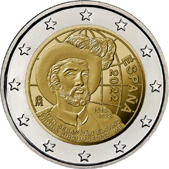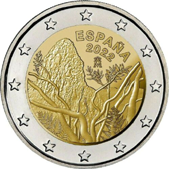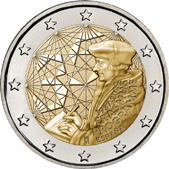2 Euro Commemorative coins Spain 2022
500 years since the completion of the first circumnavigation


The Obverse depicts the portrait of the Spanish explorer Juan Sebastián Elcano (a member of Ferdinand Magellan's expedition to circumnavigate the globe, he became commander of one of the sailing ships upon the death of the Portuguese explorer), superimposed on the design of a globe. On the right, near the inner edge, is the arched inscription "ESPAÑA", with the minting year written vertically alongside. Also on the right, superimposed on the effigy, are the years of the beginning and end of the expedition "1519" and "1522", written one below the other. On the left, between the inner border and the image, is the mintmark (the crowned "M"). At the bottom, superimposed on the portrait of the explorer and one below the other, are the circular inscriptions "JUAN SEBASTIÁN ELCANO" and "PRIMUS CIRCUMDEDISTI ME" ("You have surrounded me for the first time" in Latin, an inscription present, together with a globe, on the coat of arms that King Charles V had made in his honour). On the outside part are placed 12 five-pointed stars, the symbol of the European Union. The coin's Reverse is the new common side of Euro coins, with the face value "2" on the left and the European continent on the right, overlapped by the inscription "EURO". Six vertical lines with a star at each end are placed behind the Europe's image.
Edge: finely milled, with six "2" in incuse (repeated alternately from bottom to top and vice versa) and twelve five-pointed stars.
Diameter: 25,75 mm
Thickness: 2,20 mm
Weight: 8,5 g
Composition: bimetallic coin (outer part: copper-nickel, inner part: nickel-brass).
| Date | Rarity | Circulation coins | Uncirculated | Proof | Total mintage |
|---|---|---|---|---|---|
| 2022 | C | 995.000 | 5.000 | 1.000.000 |
Thirteenth of the UNESCO World Heritage Sites series: Garajonay National Park


The Obverse depicts some details of the Garajonay National Park, located on the island of La Gomera (one of the islands that form the Canary Islands archipelago): the Roque de Agando and a detail of the laurisilva forest (a type of tropical evergreen forest, among whose species the Azores laurel is certainly worth mentioning). At the top right, in the free space left by the design, is the circular inscription "ESPAÑA", with the minting year underneath (also written in an arc) and, immediately below, the mintmark (the crowned "M").On the outside part are placed 12 five-pointed stars, the symbol of the European Union. The coin's Reverse is the new common side of Euro coins, with the face value "2" on the left and the European continent on the right, overlapped by the inscription "EURO". Six vertical lines with a star at each end are placed behind the Europe's image.
Edge: finely milled, with six "2" in incuse (repeated alternately from bottom to top and vice versa) and twelve five-pointed stars.
Diameter: 25,75 mm
Thickness: 2,20 mm
Weight: 8,5 g
Composition: bimetallic coin (outer part: copper-nickel, inner part: nickel-brass).
| Date | Rarity | Circulation coins | Uncirculated | Proof | Total mintage |
|---|---|---|---|---|---|
| 2022 | C | 995.000 | 5.000 | 1.000.000 |
35 years of the Erasmus Programme


The Obverse depicts two key elements of the Erasmus programme, a European Union student mobility project aimed at university students. On the right is Erasmus of Rotterdam (Dutch humanist and philosopher), in one of his best-known portraits, after whom the programme was named because of his numerous journeys throughout Europe, with the aim of learning about its different cultures. The effigy of the theologian is superimposed on a net that crosses the coin from one point to the other, which is intended to represent the cultural and human exchanges between European students; on the left-hand side, thanks to a special type of graphics, the number '35' appears (to identify the 35th anniversary). Superimposed on the portrait are the circular inscriptions: "1987-2022", "ERASMUS" and "PROGRAMME" on three lines, while further down, near the inner edge, is the mintmark (the crowned "M"), followed by the inscription "ESPAÑA". Above the philosopher's right hand are the author's initials "J.J.". On the outside part are placed 12 five-pointed stars, the symbol of the European Union. The coin's Reverse is the new common side of Euro coins, with the face value "2" on the left and the European continent on the right, overlapped by the inscription "EURO". Six vertical lines with a star at each end are placed behind the Europe's image.
Edge: finely milled, with six "2" in incuse (repeated alternately from bottom to top and vice versa) and twelve five-pointed stars.
Diameter: 25,75 mm
Thickness: 2,20 mm
Weight: 8,5 g
Composition: bimetallic coin (outer part: copper-nickel, inner part: nickel-brass).
| Date | Rarity | Circulation coins | Uncirculated | Proof | Total mintage |
|---|---|---|---|---|---|
| 2022 | C | 993.500 | 6.500 | 1.000.000 |




























